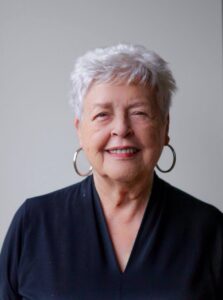Cecilia Medina Quiroga
Mainstreaming Gender in International Human Rights Law
Lawyer, judge, professor, UN legal expert, researcher – forced to start over repeatedly, Dr. Cecilia Medina Quiroga has earned herself nearly every title you could think of in the field of law. Above all, she is a specialist in international human rights law who truly believes that women’s rights can be advanced through the application of human rights. Her perspective has contributed to the development of women’s rights protection, notably in the Inter-American Court for Human Rights’ historic “Cotton Field Femicide” case over which she presided.

© Deidan42 via Wikimedia Commons
First beginnings
Cecilia Medina Quiroga was born on 17 November 1935 in Concepción, Chile, and grew up in Chile’s capital Santiago. She describes her family as progressive, with her mother and all of her aunts having university degrees, but also as rather poor, which is why she had to choose a study programme during which she could work part-time.1) She went on to study law at the University of Chile in Santiago in 1953 and graduated with summa cum laude in 1959 as Licenciada en Ciencias Jurídicas y Sociales (equivalent to a bachelor’s degree). She recalls being a curious student whose constant questions sometimes annoyed her fellow students.
After having been admitted as a lawyer and getting married, she moved to the north of Chile with her husband, where she opened up a private practice.2) She remembers struggling with demanding fees from poorer clients and describes herself as “not a good lawyer in that sense”.3) The first of many new beginnings, she separated from her husband and returned to Santiago as a single mother after nearly ten years as a practising lawyer.4) In 1969, she was able to pick up teaching constitutional law at the University of Chile. This is where she discovered her joy and talent for educating others in the field of law.5) In 1972, she became a rapporteur at the Constitutional Court of Chile.
Life in exile
However, Cecilia Medina Quiroga’s promising career opportunities were cut short after Augusto Pinochet’s coup d’état in 1973. As she and her new husband, the socialist lawyer Waldo Fortin Cabezas, were supporters of former President Salvador Allende, remaining in the country grew continuously more dangerous – this may be grimly illustrated by the execution of her cousin during the early regime days. Cecilia Medina Quiroga left Chile on 30 November 1973, after refusing to denounce Allende in order to continue working at the university.6)
Cecilia Medina Quiroga, her three children and her husband were amongst the few thousands of Chileans who fled to East Germany where they soon came to realise their professional future hardly stood any chance.7) With the help of Orlando Letelier, an exiled former diplomat for the Allende government, the Medina-Fortin-family was able to move to Washington D.C., planning on working together in academia.8) The plan fell through when in 1976, Letelier was killed by a car bomb, leading many US-Americans to become reluctant to employ Chileans with connections to him.9) Cecilia Medina Quiroga instead applied for a job as a secretary at the “Institute for the Development of Indian Law”, a non-profit Native American legal organisation. When the head of the Institute realised she surpassed even his professional qualifications, he offered her a research position to write background papers for the first International NGO Conference on Discrimination against Indigenous Populations in the Americas due in 1977.10) The work allowed Cecilia Medina Quiroga to first plunge into human rights law and discover her professional passion.11) Her situation as a political exile in Washington, however, worsened when she started to receive harassing and threatening phone calls.12)
The family thus decided to move once again, this time to the Netherlands where many other Chilean people had been granted asylum. Adjusting to yet another new country, learning a new language, and looking for a job gave Cecilia Medina Quiroga a Sisyphus-like feeling.13) Still, she managed to return to academia – the work that she felt “most happy with” at the time14) – and became a lecturer and researcher at the Faculty of Law at Utrecht University in 1980, first at the Europa Institute and then at the Netherlands Institute of Human Rights. Despite the challenges she faced, she finished her dissertation “The Battle of Human Rights – Gross, Systematic Violations and the Inter-American System” in 1988 – as, what some have deemed necessary to point out, an over fifty-year-old grandmother.15) As a lecturer, she broadened the faculty’s human rights curriculum by teaching (comparative) courses on the Inter-American system for the first time.16)
Return to Chile
After Pinochet was forced to accept the end of his dictatorship in 1990, Cecilia Medina Quiroga was able to return to her home country. She used her connection to the new Chilean foreign minister – also her former superior at the University of Chile – to receive a nomination for the UN Human Rights Committee.17) She was elected in 1995 and served an eight-year term, from 1999 to 2000 as Chair of the Committee. One of her outstanding achievements as Chair was the drafting of General Comment 28 on Art. 3 of the International Covenant on Civil and Political Rights. It updated the Committee’s interpretation of the equality of rights between men and women, e.g. declaring that the criminalisation of abortion may violate the right to life and personal integrity. Cecilia Medina Quiroga found that her experience as a member of an UN treaty body gained her the ability to critically assess her “own continental culture and traditions”.18)
This insight proved to be valuable when she became the second female judge at the Inter-American Court for Human Rights based in Costa Rica in 2004. From 2008 to 2009 she was its first female president. She was an expert fit for the position since the court had to deal with gross human rights violations on a large scale – the topic on which she wrote her dissertation. Her work at the court was certainly guided by her belief that in a legal context, “women’s problems” could be solved by the interpretation of human rights law. This principle she had already pointed out in 1995:
“As you know, whenever a lawyer reads a legal provision, the first thing she says when asked about its meaning is ‘It depends.’ Often, the reader makes the law more than the law makes the reader. Therefore, if we read the law with women’s eyes, we probably will be able to go a long way into incorporating economic, social, and cultural rights into civil and political rights, which are much better protected at the international level.”
The Cotton Field femicide
Of the seventy cases for which Cecilia Medina Quiroga set on the bench, one in particular stands out for its impact on gender jurisprudence: the “Cotton Field Femicide” case (González et al. vs. Mexico).19) The case occurred in the context of an increased number of abductions and murders of women in Ciudad Juárez in the 1990s/early 2000s. In Autumn 2001, Claudia Ivette González (20), Esmeralda Herrera Monreal (15) and Laura Berenice Ramos Monárrez (17) disappeared after leaving work. Their family frequently contacted the police, but they failed to launch a real investigation, basing their indifference on sexist stereotypes, e.g. suggesting the young woman and girls had probably run off with their boyfriends. In November 2001, the bodies of the three were found in a cotton field together with the bodies of five other young women. The Tribunal concluded that they had been held captive, showed signs of severe mental and physical suffering, and very possibly experienced sexual violence.
The Tribunal found that the Mexican State had violated several of the rights enshrined in the American Convention on Human Rights, particularly the right to life, the right to humane treatment and the right to personal liberty. Since it could not be proven that the state was actively involved in the disappearance and abuse of the girls, the Tribunal had to establish that the obligation to guarantee human rights includes the duty to prevent violations. In this way, the judgment marks an important precedent for states’ responsibility for violence against women by private actors – the lack of which had often been criticised in feminist legal theory. Significantly, the Tribunal also found violence against women to constitute gender discrimination and acknowledged its structural context. Based on that, it ordered reparations not only as damage payments for the next of kin but with a transformative aim, such as creating a national memorial for the victims, conducting a new investigation of the murders, and improving prevention measures.
Whether this groundbreaking precedent would have been set in the same way without the influence of Cecilia Medina Quiroga remains mere speculation. In any event, it does align with her body of work. In her concurring opinion she even criticised that the Tribunal would not classify the lack of prevention of the abusive acts as torture.
Academic work and legacy
In between and during her international positions, Cecilia Medina Quiroga kept on working in academia: since 1990 as a professor of international law at Diego Portales University in Santiago, and since 1997 at the University of Chile, where she co-founded the Human Rights Centre in 2002. Apart from that, she has worked as a guest professor at numerous institutions such as Harvard Law School. She received the status of professor emeritus from the University of Chile in 2016 and from Diego Portales University in 2018. During her long academic career, she has published extensively on human rights law with a special focus on the Inter-American system as well as women’s rights. Her work of mainstreaming women’s rights through the international legal framework has won her many prizes, most notably the Gruber Women’s Rights Prize in 2006. Even at almost ninety years old, she remains an influential voice: Last year, she delivered a powerful speech on democracy and human rights at an award ceremony, reminding the next generation of young lawyers that
“Our fight is far from over. The challenges we face today in the field of human rights are perhaps less visible, but no less important than half a century ago. Inequality, discrimination, gender-based violence, the rights of indigenous peoples, the climate crisis and its effects on human rights are just some of the fronts on which we must continue to fight, and of course, the outstanding debt to unresolved disappearances and justice for those who suffered mass violations must always be present in our thinking.”
It is not only her legal thinking that offers inspiration, but also her personal life. Cecilia Medina Quiroga’s story serves as a reminder to stay resilient, to remain true to our values and to let our work be guided by them.
Further readings and sources:
- Daniel Terris, Cesare P. R. Romano, Leigh Swigart, The International Judge: An Introduction to the Men and Women who Decide the World’s Cases, 2007, 180-190.
- Cecilia Medina Quiroga, The Battle of Human Rights, 1988.
- Cecilia Medina Quiroga, The Inter-American Commission on Human Rights and Women, with particular reference to violence, in Castermans et al., The role of the nation-state in the 21st century: human rights, international organisations and foreign policy, 1998.
- Cecilia Medina Quiroga, The Role of International Tribunals: Law-Making or Creative Interpretation, in Shelton, The Oxford Handbook of International Human Rights Law, 2015, 649-669.
- Interview (in Spanish) with the Dominican Fundación Institucionalidad y Justicia: Conversatorio FINJUS: Magistrada Cecilia Medina Quiroga (youtube.com).
- Video (in Spanish) about Cecilia Medina Quiroga’s professional life, including many old photographs: MASTER CECILIA MEDINA (youtube.com).
References
| ↑1 | Cf. Daniel Terris, Cesare P. R. Romano, Leigh Swigart, The International Judge: An Introduction to the Men and Women who Decide the World’s Cases, 2007, 180-181. |
|---|---|
| ↑2 | Id., 181. |
| ↑3 | Id. |
| ↑4 | Cf. id. |
| ↑5 | Cf. id., 181-182. |
| ↑6 | Cf. id., 182; Cecilia Medina Quiroga, The Battle of Human Rights, 1988, VII. |
| ↑7 | Cf. Terris et al., International Judge (n. 1), 182. |
| ↑8 | Robert T. Coulter, Reflexiones sobre Cecilia Medina, in Óscar Parra Vera et al., La Lucha por los Derechos Humanos Hoy – Estudios en Homenaje a Cecilia Medina Quiroga, 2017, 29. |
| ↑9 | Cf. id. |
| ↑10 | Cf. id., 29-30. Her work helped lay the foundation to the adoption of the UN Declaration on the Rights of Indigenous Peoples by the UNGA 30 years later. |
| ↑11 | Cf. Terris et al., International Judge (n. 1), 183. |
| ↑12 | Coulter, Reflexiones (n. 8), 30. |
| ↑13 | Leo Zwaak, Some memories to Cecilia Medina Quiroga, my great friend and teacher, in Óscar Parra Vera et al., La Lucha por los Derechos Humanos Hoy – Estudios en Homenaje a Cecilia Medina Quiroga, 2017, 25-26. |
| ↑14 | Medina Quiroga, Battle of Human Rights (n. 6), VII. |
| ↑15 | Cf. Terris et al., International Judge (n. 1), 184; Zwaak, Some memories (n. 13), 36. |
| ↑16 | Zwaak, Some memories (n. 13), 36-37. |
| ↑17 | Terris et al., International Judge (n. 1), 184. |
| ↑18 | Cecilia Medina Quiroga, The Role of International Tribunals: Law-Making or Creative Interpretation, in Shelton, The Oxford Handbook of International Human Rights Law, 2015, 650. |
| ↑19 | Cecilia Medina Quiroga explained that the judgment refrains from calling the murders “femicide” because of its various definitions in academia and activism. |



